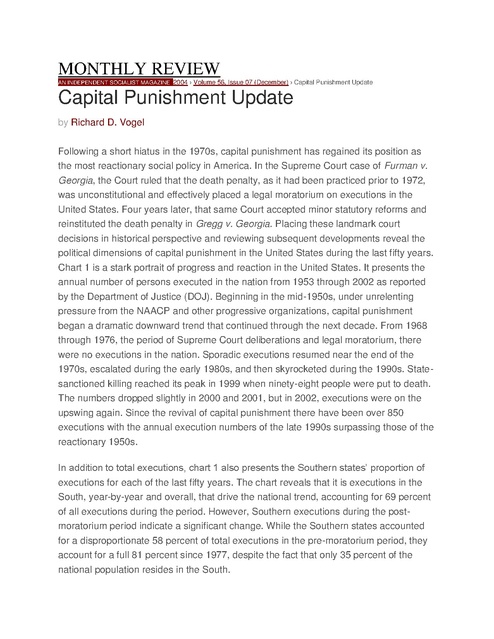Capital Punishment Update, Vogel, 2004
Download original document:

Document text

Document text
This text is machine-read, and may contain errors. Check the original document to verify accuracy.
MONTHLY REVIEW AN INDEPENDENT SOCIALIST MAGAZINE 2004 › Volume 56, Issue 07 (December) › Capital Punishment Update Capital Punishment Update by Richard D. Vogel Following a short hiatus in the 1970s, capital punishment has regained its position as the most reactionary social policy in America. In the Supreme Court case of Furman v. Georgia, the Court ruled that the death penalty, as it had been practiced prior to 1972, was unconstitutional and effectively placed a legal moratorium on executions in the United States. Four years later, that same Court accepted minor statutory reforms and reinstituted the death penalty in Gregg v. Georgia. Placing these landmark court decisions in historical perspective and reviewing subsequent developments reveal the political dimensions of capital punishment in the United States during the last fifty years. Chart 1 is a stark portrait of progress and reaction in the United States. It presents the annual number of persons executed in the nation from 1953 through 2002 as reported by the Department of Justice (DOJ). Beginning in the mid-1950s, under unrelenting pressure from the NAACP and other progressive organizations, capital punishment began a dramatic downward trend that continued through the next decade. From 1968 through 1976, the period of Supreme Court deliberations and legal moratorium, there were no executions in the nation. Sporadic executions resumed near the end of the 1970s, escalated during the early 1980s, and then skyrocketed during the 1990s. Statesanctioned killing reached its peak in 1999 when ninety-eight people were put to death. The numbers dropped slightly in 2000 and 2001, but in 2002, executions were on the upswing again. Since the revival of capital punishment there have been over 850 executions with the annual execution numbers of the late 1990s surpassing those of the reactionary 1950s. In addition to total executions, chart 1 also presents the Southern states’ proportion of executions for each of the last fifty years. The chart reveals that it is executions in the South, year-by-year and overall, that drive the national trend, accounting for 69 percent of all executions during the period. However, Southern executions during the postmoratorium period indicate a significant change. While the Southern states accounted for a disproportionate 58 percent of total executions in the pre-moratorium period, they account for a full 81 percent since 1977, despite the fact that only 35 percent of the national population resides in the South. The issue of the death penalty is more critical now than it was in 1972. Then there were 334 prisoners under sentence of death in the United States—today there is more than ten times that number. Chart 2, also based on DOJ statistics, presents the number of prisoners on death row in the United States for the years 1953–2001. Chart 2 reveals that there has been a steep and steady increase of prisoners on death row from the early 1980s through the end of the century. The low point in the series was 1973 when there were only 153 prisoners awaiting execution, and the highest number was 3,601 in 2001. The burgeoning death row prisoner population of the post-moratorium period was one of the targets of the Republican Contract with America. Neoconservative politicians promised to speed up the pace of executions and delivered the means to do so in the Anti-Terrorism and Effective Death Penalty (ATEDP) Act that was signed into law in 1995. The ATEDP Act streamlined the execution process by restricting prisoners’ right of habeas corpus, the rule of law that allows inmates to challenge their convictions. The steep rise of executions in the late 1990s corresponded with the passage of the ATEDP (see chart 1). The current high death row populations and execution rates are the result of capitalist “law and order” policies. The recent history of capital punishment in the United States shows that the death penalty remains the deadliest weapon of class struggle in America and that reactionaries will never give it up without a fight.

